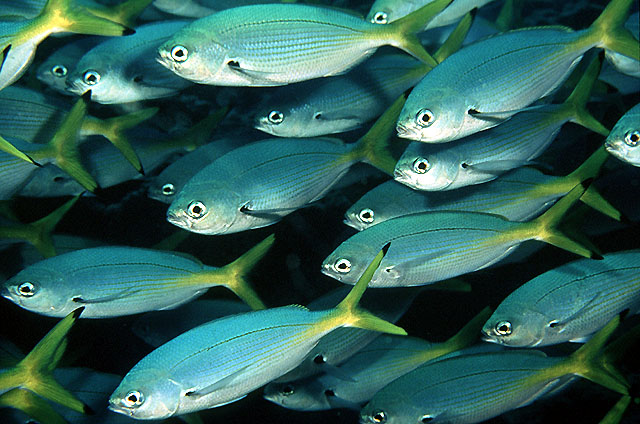| Caesionidae (Fusiliers), subfamily: Caesioninae |
| 40 cm TL (male/unsexed) |
|
reef-associated; depth range 0 - 50 m, non-migratory |
| Indo-West Pacific: Red Sea, Persian Gulf and East Africa to the Solomon Islands, north to southern Japan. |
|
Dorsal spines (total): 10-10; Dorsal soft rays (total): 13-15; Anal spines: 3-3; Anal soft rays: 10-11. Bluish body, pale ventrally; caudal lobe tips, axil and upper base of pectoral fin black. Juveniles with yellow tails and black tips. 4-5 scales on cheek; 18-25 predorsal scales; scaled dorsal and anal fins. Upper peduncular scale rows usually 10 or 11 (9-13); lower peduncular scale rows usually 14 or 15 (13-15). Supra-temporal band of scales interrupted by a thin scaleless zone at dorsal midline. basioccipital process for attachment of Baudelot's ligament absent. Post maxillary process single; posterior end of maxilla blunt (Ref. 1723). Head length 2.6-3.5 in SL; body depth 2.5-3.5 in SL (Ref. 90102). |
| Found in coastal areas, mainly on or near coral reefs (Ref. 30573). More common along steep seaward reefs than in lagoons (Ref. 9710). Forms large aggregations in midwater on upper edge of steep slopes and around patch reefs, often with other fusiliers (Ref. 90102). Feeds on zooplankton. Oviparous, with numerous, small pelagic eggs (Ref. 402). |
|
(Ref. 96402)
|
| harmless |
|
Source and more info: www.fishbase.org. For personal, classroom, and other internal use only. Not for publication.
Page created by Jen, 05.08.02,
php script by kbanasihan 06/09/2010 ,
last modified by
dsantos, 20/08/10

